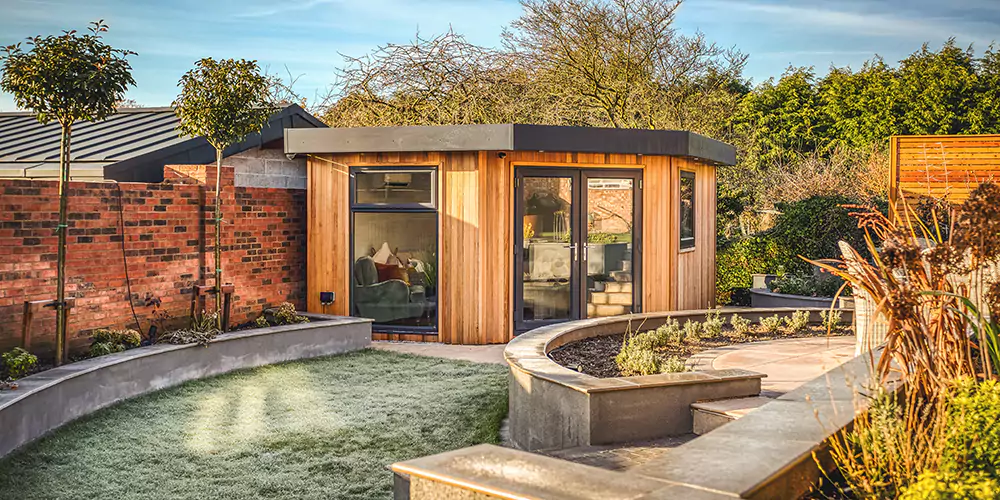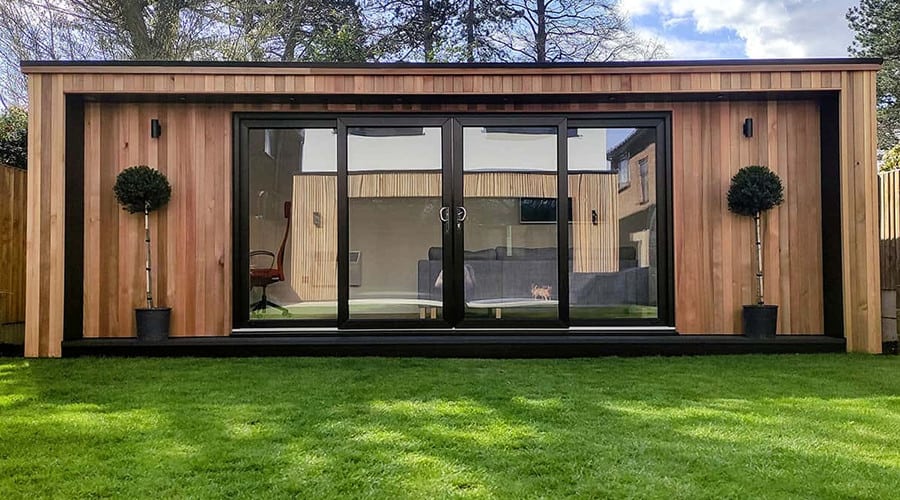Specific size restrictions are often used to determine if you need planning approval when making garden rooms, conservatories or outhouses. Here's the criteria for size that may require you to obtain planning permission.
If you're planning to construct a detached structure then you must get permission if your proposed construction or any outbuildings exceed 50% of the entire surface of the land around the original home.
Height limitations:
Buildings with a single story: The maximum height of the eaves should not exceed 2,5 meters. For roofs that have dual pitches, the maximum height must not exceed 4 meters.
If the building is within two meters of the property boundary it cannot be more than 2.5 meters.
Floor Area:
The floor space of structures with larger than 30 square meters could need building regulations approval even if planning permission isn't necessary.
Proximity to Boundaries:
If the structure is within 2 meters of an area boundary, it's usually required to apply for permission for planning for structures with a height greater than 2.5 meters.
Building Usage
While it's not a strictly defined size restriction, the intended purpose of the garden will determine whether planning permission is required. For instance, if the structure is intended being used as a residences or office space Planning permission will be more likely to be needed.
Permitted Development Rights:
Permitted Development Rights have specific restrictions on size and conditions. These rights vary depending on whether the property is in a conservation area or subject to other restrictions.
Conservatories, extensions, and other conservatories of different types:
For single-story rear extensions, the maximum depth of an extension is usually 4 metres for detached homes and 3 metres for semidetached or terraced homes. These can be extended to 8 meters or 6 meters, for example as per the Neighbour Consultation Scheme, subject to a few conditions.
The height limit for an extension in the rear that is single story is 4 meters.
Side Extensions
For extensions on the sides, width and height must not exceed four meters.
Volume Restrictions
In certain zones (such as Conservation Areas and Areas of Outstanding Natural Beauty) A building addition which increases the size of the initial house by more than ten percent (10%) or 50 cubic meters (whichever amount is greater) will need planning approval.
Front Extenders
Planning permission is required for any extensions that extend beyond the front of the house.
Contact your local authorities because the rules could differ depending on local councils and the conditions of your property. Even if no planning permission is required, a building permit under the building regulations may still be needed to ensure structural integrity and safety reasons. Take a look at the top rated cedar garden office for blog recommendations including herts garden rooms, outhouses, gym outhouse, garden outhouse, luxury outhouse, out house, garden room permitted development, out house for garden, garden room planning permission, luxury outhouse and more.

What Permissions Do You Require For Garden Rooms And Other Listed Buildings?
When planning to build garden rooms outhouses, conservatories, garden offices, or extensions on the grounds of a listed structure, specific considerations and more stringent rules are in place. Here are the key details regarding planning permission for these types of projects A Listed Building Consent is required:
Typically, any modifications, extensions, or new structures within the boundaries of a designated building need the approval of a listed building along with planning approval. Changes can affect the special character of the listed building.
The impact on the character of historical characters
This covers garden rooms as well as outbuildings. Outbuildings and garden rooms are also included.
Materials and Design
The style and materials should reflect the historical and architectural significance of the structure. It may be necessary to design bespoke plans and the utilization of traditional materials, which requires the approval of a planner.
Close proximity to the listed building
It is crucial to think about the potential impact on any future structures that are located near the heritage building. To ensure that they don't detract the character of the building it is necessary to obtain planning permission.
Size and Scale
The extension, garden room or conservatory should be proportional and harmonies with the existing listed building. The larger building is more likely to require an in-depth assessment and planning permit.
The Property Location:
The site of new structures (whether they are located in front, on the rear or on the side of an existing building) could affect the need for approval of the plan. Visible locations, or those that affect key views of the structure need to be evaluated more thoroughly.
Changes in the internal structure:
Even if you're removing the structure that was previously in use, any internal modifications that are made to the building must also have planning approval and the building's listed consent.
Conservation Area Overlap
Additional restrictions are in place when a listed building is located in a designated conservation area. To ensure that the building is in compliance with the listed building regulations as well as conservation area regulations, planning permission is needed.
The Building is Used for:
Planning permission may be needed dependent on the purpose for which the garden room or outbuilding will be used for. The authority for planning will pay greater attention to uses that indicate significant changes for commercial or residential use.
Structural Impact
If a construction could compromise the structural integrity of the structure, it will require approval for planning.
Local Authority Guidelines:
Local authorities have guidelines that outline what type of construction or modification is permitted on listed structures. Planning permission is needed to ensure that these rules are observed.
Professional Assessments
Conservation experts often need to conduct thorough reviews of any proposed work that is planned on heritage-listed buildings. These assessments help determine if modifications proposed are acceptable and also to back the application for planning permission.
In summary, planning permission and listed building approval are almost always needed when making conservatories, garden spaces, outhouses, office buildings or extensions that are associated with an approved building. Consult with your local planning authority and heritage professionals early in the planning process is essential to ensure compliance with all applicable laws and regulations, as well as to protect the historic and architectural integrity of the property. See the most popular ground screw vs concrete for more advice including conservatories and garden rooms, costco garden office, garden office hertfordshire, what size garden room without planning permission, Tring garden rooms, how to get power to a garden room, costco garden room, armoured cable for garden room, garden outhouse, ground screws vs concrete and more.

What Kind Of Permit Do You Require For Gardens Or Other Structures That Are Located On Agricultural Land?
There are certain restrictions and regulations to obtain planning permission for the construction of conservatories, outhouses, or gardens offices on land used for agriculture. These are the most important points Change of Use:
The land that is that is designated as agricultural is normally utilized for agricultural or related activities. Planning permission is typically needed to alter the land's use to gardens or residential. It is necessary to obtain planning permission since the land's agriculture will change.
Permitted Development Rights:
Land for agriculture often has different development rights that are permitted compared with residential land. For instance, certain kinds of agricultural buildings may be erected without full planning permission, but these rights are typically for agricultural-related structures, not residential garden rooms or offices.
Size and Scale
The proposed size and scope of the building will determine the amount of planning permission required. Larger structures or encompass a large amount of land will be more likely to need planning permission.
Impact on Agriculture:
More likely is that planning permission is required if a new structure interferes with the use of agricultural the land. For example, reducing the amount of land available for agriculture or animals.
Green Belt Land:
If the land for agriculture is also designated Green Belt, there are additional restrictions aimed at preventing urban sprawl and preserving open space. Any new building or structure built upon Green Belt Land is required to be granted planning permission and meet certain criteria.
Design and Appearance:
The style and design of the building must be in keeping with the rural characteristics of the region. Planning approval is needed to ensure that the construction project will not adversely affect the natural appearance or the landscape.
Environmental Impact:
Environmental impact is a consideration when building on land that is agricultural. A study of the environment may be required to obtain planning approval to ensure the new structure won't cause harm to wildlife habitats and ecosystems in the area.
Proximity to existing buildings:
The distance between the proposed garden office and the existing agricultural structures may impact planning requirements. Buildings constructed close to existing farm buildings may be viewed differently from those in open fields.
Access and Infrastructure:
It is important to consider the effect on infrastructure for example, roads, water, and waste management. The planning permission will determine if the existing infrastructure can support a new building.
Use Class Orders:
Planning law defines the use classes that are applicable to agricultural land. To ensure that the new usage is in line with local policies regarding planning, it's often required to seek planning approval prior to modifying the class.
Local Planning Policies
Local planning authorities have their own policies regarding agricultural land. Planning permission is granted for nonagricultural structures based on these policies, which take into account local development plans as well as community needs.
National Planning Policy Framework
In the UK the National Planning Policy Framework gives guidelines for how to utilize and develop land. The planning permission granted to agricultural structures will be assessed according to NPPF which is focused on sustainable development and the protection of rural areas.
In conclusion, planning permission is usually required for the construction of gardens, conservatories, or outhouses on agricultural land. The requirement to change the land use and conform to the national and local policies on planning are the main reason for this. Contact the local authority for planning to learn about the regulations and obtain the permits you need. View the most popular cabin heater for more info including armoured cable for garden room, what size garden room without planning permission, garden room, costco garden buildings, garden rooms brookmans park, costco garden rooms, composite summer house, garden buildings , outhouse for garden, garden room heater and more.
